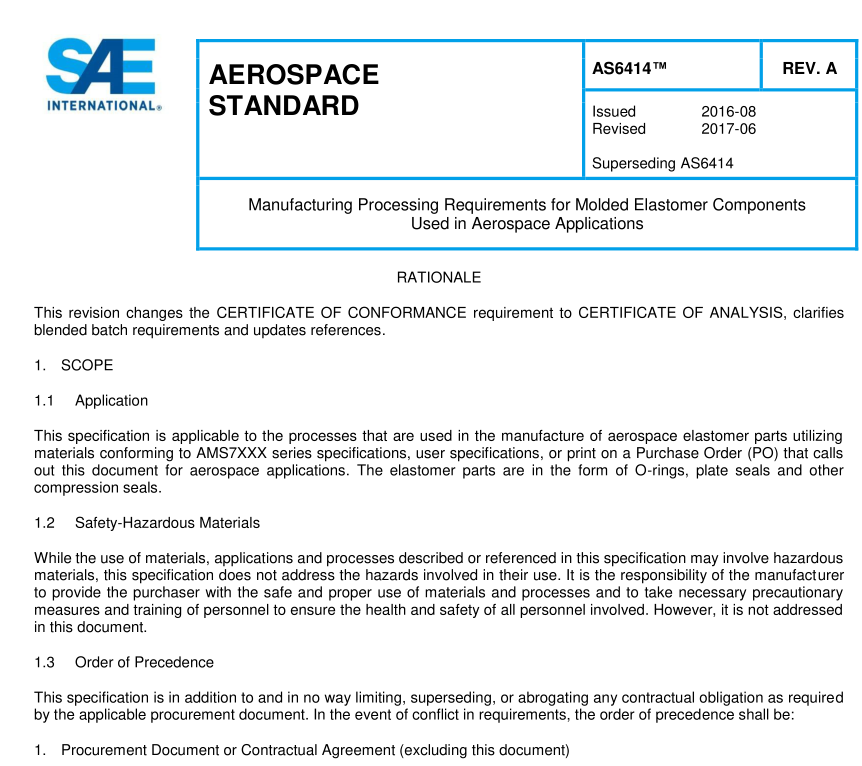SAE AS 6414A pdf download – Manufacturing Processing Requirements for Molded Elastomer Components Used in Aerospace Applications

SAE AS 6414A pdf download – Manufacturing Processing Requirements for Molded Elastomer Components Used in Aerospace Applications
4.2Blending of Compound
4.2.1.1 lf the practice is observed for blending batches, the compounder/manufacturer shall have a material approval
process,which shall include these minimum requirements. These minimum requirements are applicable to allmaterials conforming to AMS7XXX series specifications, user specifications, or print on a Purchase Order (Po)that calls out this document for aerospace applications.
4.2.1.1.1 The original batch numbers and weights utilized in the blended batch shall be documented and easily
accessible.
The original batches used shall be the same formulation and the same mix location.
The original batches used in creating a blended batch shall meet all of the acceptance, lot testing, and shelf liferequirements of 4.1.3.2.1 prior to blending.
4.2.1.1.4
The new, blended batch shall be tested for batch and lot acceptance testing prior to shipment.
4.2.1.1.5
The new, blended batch shelf life shall be based on the oldest original batch date of manufacture and shallfollow the requirements of 4.1.3.2.1 for shelf life extension.
4.2.1.1.6 Blended material cannot be blended a second time.4.3Preforms
4.3.1 Preform type and machine operating conditions shall be defined, documented in the work order and available to the
operator. Documentation shall be available to verify that preforms were properly made.
4.3.2 The manufacturer shall have a process for managing the shelf life of preforms. If the shelf life cannot be determined
or is not identified, then it shall default to the expiration date of the compound.
4.4 Mold Approval
4.4.1 The manufacturer shall have a mold approval process.
4.4.1.1 Molds should be verified prior to the first production run but in those cases where this is not possible they shall
be verified prior to shipment of parts. The manufacturer shall have a procedure for verifying the mold.Anyadditional purchase document, drawing or specification requirements.(e.g., first article process, etc.) shall becomplied with.The mold approval documentation shall be recorded and stored per the manufacturer’s recordretention policy.
4.4.1.2 The manufacturer shall have a procedure to segregate parts made in a mold that has not been verified and the
parts shall remain segregated in production until the mold has been verified.
4.4.1.3
Having nonconforming cavities in a mold does not disqualify a mold from use if the manufacturer has a policy inplace to clearly identify nonconforming parts produced in nonconforming cavities to isolate and prevent shippingnonconforming parts to the customer.
4.4.1.4 lf a mold is required to be repaired, the manufacturer shall have a process to validate conformance.4.5Set up
4.5.1 The press and mold are set up per the manufacturer’s process instructions specific to the method of manufacture
such as compression, transfer or injection molding.Set up includes temperature, pressure and time. All controlsshall be calibrated.
4.5.2 Confirmation that the set up was completed successtfully shall be documented per manufacturer’s procedures prior
to beginning the production run.
4.6Molding
4.6.1 Mold parts per process instructions specified on the manufacturer’s Work Order.
4.6.2 Time and temperature shall be recorded, monitored, and controlled per the manufacturer’s Work Order.4.7Deflash
4.7.1 Manufacturer shall have process instructions on the Work Order specific to the method of deflash for the parts such
as cryogenic, hand, etc.
4.8Post Cure (lf Required)
4.8.1 The Production oven shall be calibrated in accordance with one of the following:1. The Temperature Uniformity Survey (TUS) procedure outlined in Appendix A, or
2. ASTM D7969 Standard Specification for Gravity Convection and Forced ventilation Ovens, or3. ASTME145 Standard Specification for Gravity-Convection and Forced-ventilation Ovens, or4.AMS2750
Pyrometry.
4.8.1.1 Parts shall be placed in a post cure oven and separated as appropriate, by lotigeometry to maintain traceability,4.8.1.2 The post cure procedure shall require that the parts are placed to allow even distribution of heat during the post
cure process.
NOTE:Fluoro ilicone and silicone parts shall not be post cured in the same oven as parts molded from other polymers as
the off gassing products from fluorosilicone and silicone parts can adversely affect the parts molded from otherpolymers.
4.8.1.3 Time and temperature shall be controlled per the process posted on the Work Order. Time and temperature shall
be monitored and recorded.
5.INSPECTION
The manufacturer shall have a procedure to document all parts being inspected with the inspection criteria per the PartStandard or the Purchase Order. if no visual requirement is specified use lSO 3601-3, Grade S orAS5752 Typell dependingon the geometry.
5.1.1 Visual discrepancies outside the allowable limits shall be a cause for rejection.
5.1.2—Exceptions to any customer requirement shall be noted and the customer’s written acceptance or acknowledgement
of each exception shall be kept and stored in accordance with the manufacturer’s record retention policy.
5.1.3 Dimensional verification shall be conducted as specified per Contract, Purchase Order, Part Standard or Print. lf
not specified then the default requirement sampling plan shall be in accordance with the ANSIASQ Z.1.4,C=0,AQL 2.5.Parts that do not meet the dimensional requirements shall be discarded.Both AS568 and lS0 3601-1establish standard O-ring sizes and Tolerances.









